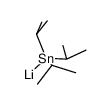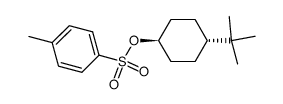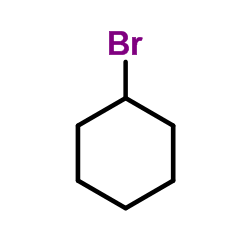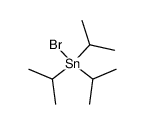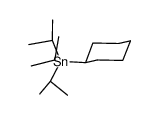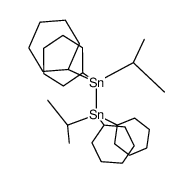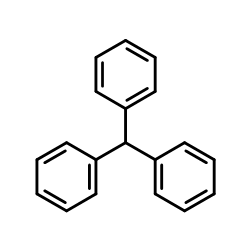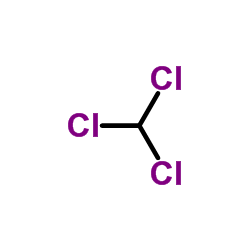2949-42-0
| Name | tetra(propan-2-yl)stannane |
|---|---|
| Synonyms |
TETRAISOPROPYLTIN
EINECS 220-969-5 tetraisopropyl stannane Tetraisopropylzinn STANNANE,TETRAISOPROPYL MFCD00026346 tetra-i-propyltin tetrapropan-2-ylstannane Tetraisopropyl-stannan |
| Density | 1.124 g/cm3 |
|---|---|
| Boiling Point | 89ºC (4 torr) |
| Molecular Formula | C12H28Sn |
| Molecular Weight | 291.05200 |
| Flash Point | >38ºC |
| Exact Mass | 292.12100 |
| LogP | 5.07520 |
| Vapour Pressure | 0.0428mmHg at 25°C |
| Index of Refraction | 1.4851 |
|
Section 1: Product Identification Chemical Name:Tetra-i-propyltin, min. 98% CAS Registry Number:2949-42-0 Formula:Sn(C3H7)4 EINECS Number:220-969-5 Chemical Family:organotin compound Synonym:Tetrakis(i-methylethyl)stannane
Section 2: Composition and Information on Ingredients IngredientCAS NumberPercentACGIH (TWA)OSHA (PEL) Title Compound2949-42-0100%0.1mg/m30.1mg/m3 Section 3: Hazards Identification Irritating to skin, eyes and respiratory tract. Organo tin compounds may act as delayed poisons, causing Emergency Overview: headache, psycho-neurologic disturbances, vision impairment; skin burns, liver and kidney damage. Primary Routes of Exposure:Ingestion, inhalation, skin, eyes Eye Contact:Causes severe irritation of the eyes. Causes slight to mild irritation of the skin. Prolonged contact may dry the skin and lead to rashes or more Skin Contact: severe irritation. Irritating to the nose, mucous membranes and respiratory tract. High doses may cause long term neurological Inhalation: damage. Delayed and permanent psycho-neurologic disturbances; impairment of vision, unsteadiness, nausea and Ingestion: vomiting. Irritating to skin, eyes and mucous membranes. Ingestion of certain organotin compounds may cause delayed Acute Health Affects: poisoning (4 days) with cerebral edema causing damage to the central nervous system. Repeated exposure to certain organic tin compounds may cause problems with vision, skin, respiratory Chronic Health Affects: system, central nervous system, liver, kidneys, urinary tract, and blood . NTP:No IARC:No OSHA:No SECTION 4: First Aid Measures Immediately flush the eyes with copious amounts of water for at least 10-15 minutes. A victim may need Eye Exposure: assistance in keeping their eye lids open. Get immediate medical attention. Wash the affected area with water. Remove contaminated clothes if necessary. Seek medical assistance if Skin Exposure: irritation persists. Remove the victim to fresh air. Closely monitor the victim for signs of respiratory problems, such as difficulty Inhalation: in breathing, coughing, wheezing, or pain. In such cases seek immediate medical assistance. Seek medical attention immediately. Keep the victim calm. Give the victim water (only if conscious). Induce Ingestion: vomiting only if directed by medical personnel. SECTION 5: Fire Fighting Measures Flash Point:no data Autoignition Temperature:no data Explosion Limits:no data Extinguishing Medium:carbon dioxide, foam or dry powder Fire fighters should be equipped with a NIOSH approved positive pressure self-contained breathing apparatus Special Fire Fighting Procedures: and full protective clothing. Hazardous Combustion andcarbon monoxide, carbon dioxide, soot, organic fumes and tin compounds. Decomposion Products: Unusual Fire or Explosion Hazards: No unusual fire or explosion hazards. SECTION 6: Accidental Release Measures Small spills can be mixed with vermiculite, ground limestone, sodium carbonate or other suitable Spill and Leak Procedures: noncombustible adsorbent and swept up. SECTION 7: Handling and Storage Handling and Storage:Store in a cool, dry, well ventilated area away from heat and direct sunlight. Keep containers tightly sealed. SECTION 8: Exposure Controls and Personal Protection Eye Protection:Always wear approved safety glasses when handling a chemical substance in the laboratory. Skin Protection:Wear protective clothing and gloves. Consult with glove manufacturer to determine the proper type of glove. Ventilation:Work with this product in a well-ventilated area, preferably a fume hood. If ventilation is not available a respirator should be worn. The use of respirators requires a Respirator Respirator: Protection Program to be in compliance with 29 CFR 1910.134. Ventilation:Work with this product in a well-ventilated area, preferably a fume hood. Additional Protection:No additional protection required. SECTION 9: Physical and Chemical Properties Color and Form:colorless liq. Molecular Weight:291.05 Melting Point:no data Boiling Point:112-114°C /18 mm Vapor Pressure:no data Specific Gravity:no data Odor:not determined Solubility in Water:insoluble SECTION 10: Stability and Reactivity Stability:air and moisture stable Hazardous Polymerization:no hazardous polymerization Conditions to Avoid:none Incompatibility:strong oxidizing agents and halogens Decomposition Products:carbon monoxide, carbon dioxide, tin oxide, and organic fumes. SECTION 11: Toxicological Information RTECS Data:Intravenous (mouse); LD50: 56 mg/kg. Carcinogenic Effects:No data available Mutagenic Effects:No data available Tetratogenic Effects:No data available SECTION 12: Ecological Information Ecological Information:No information available SECTION 13: Disposal Considerations Disposal:Dispose of according to federal, state, and local regulations. SECTION 14: Transportation Shipping Name (CFR):Non-hazardous Hazard Class (CFR):NA Additional Hazard Class (CFR):NA Packaging Group (CFR):NA UN ID Number (CFR):NA Shipping Name (IATA):Non-hazardous Hazard Class (IATA):NA Additional Hazard Class (IATA):NA Packaging Group (IATA):NA UN ID Number (IATA):NA SECTION 15: Regulatory Information TSCA:Not listed in the TSCA inventory. SARA (Title 313):Title compound not listed. Second Ingredient:none SECTION 16 - ADDITIONAL INFORMATION N/A |
CHEMICAL IDENTIFICATION
HEALTH HAZARD DATAACUTE TOXICITY DATA
|
| Risk Phrases | R36/37/38 |
|---|---|
| Safety Phrases | 26-36/37/39 |
| RIDADR | UN2788 |
| Packaging Group | II |
| Hazard Class | 6.1 |
| HS Code | 2931900090 |
|
~23% 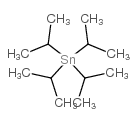
2949-42-0 |
| Literature: Sasin et al. Journal of Organic Chemistry, 1958 , vol. 23, p. 1366 |
|
~0% 
2949-42-0
Detail
|
| Literature: Olszowy, Henry A.; Kitching, William Organometallics, 1984 , vol. 3, p. 1670 - 1675 |
|
~55%
Detail
|
| Literature: Organometallics, , vol. 1, p. 1244 - 1246 |
|
~% 
2949-42-0 |
| Literature: Comptes Rendus Hebdomadaires des Seances de l'Academie des Sciences, , vol. 249, p. 1359 |
|
~% 
2949-42-0 |
| Literature: Comptes Rendus Hebdomadaires des Seances de l'Academie des Sciences, , vol. 240, p. 1732 |
|
~% 
2949-42-0 |
| Literature: Zeitschrift fuer Anorganische und Allgemeine Chemie, , vol. 384, p. 89 - 96 Sn: Org.Verb.1, 1.1.1.4.1, page 90 - 91 |
|
~% 
2949-42-0 |
| Literature: Bulletin de la Societe Chimique de France, , vol. 22, p. 12 Sn: Org.Verb.1, 1.1.1.4.1, page 90 - 91 |
| Precursor 7 | |
|---|---|
| DownStream 10 | |
| HS Code | 2931900090 |
|---|---|
| Summary | 2931900090. other organo-inorganic compounds. VAT:17.0%. Tax rebate rate:13.0%. Supervision conditions:AB(certificate of inspection for goods inward,certificate of inspection for goods outward). MFN tariff:6.5%. General tariff:30.0% |


